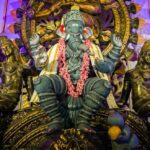Ganesh Chaturthi, one of India’s most widely celebrated festivals, spans ten days of elaborate rituals and grand festivities. Dedicated to Lord Ganesha, the elephant-headed deity symbolizing wisdom and prosperity, this Hindu festival holds deep cultural and religious significance. The ten-day celebration, also called “Vinayaka Chaturthi,” reflects various aspects of mythology, spirituality, and community bonding.
Historical Origins of Ganesh Chaturthi
The origins of Ganesh Chaturthi are rooted in ancient Hindu mythology. According to legend, Goddess Parvati created Lord Ganesha from the dirt of her body as she bathed, giving life to the idol. She tasked him with guarding her chamber. When Lord Shiva, Parvati’s husband, attempted to enter, Ganesha, unaware of his father’s identity, blocked the way. Angered, Shiva beheaded Ganesha. Upon realizing the loss, Parvati was devastated, and she urged Shiva to restore their son’s life. In response, Shiva replaced Ganesha’s head with that of an elephant, giving him a new life and divine powers.
The Ten-Day Observance
The festival begins with the installation of Ganesha idols in homes and public spaces on the first day. This is marked by the Pranapratishtha ritual, which invokes the divine presence of Lord Ganesha in the idol. Over the next nine days, devotees offer prayers, flowers, modak (a special sweet), and coconuts as part of daily rituals. Cultural events, such as music and dance performances, further enliven the celebration.
Each day of the festival has its unique significance, but together they symbolize Ganesha’s journey from his heavenly abode to Earth, where devotees joyfully welcome him. The festive atmosphere, combined with acts of devotion, exemplifies the strong connection between faith and cultural expression.
Ganesh Visarjan: The Final Day
The festival reaches its climax on the tenth day, known as “Anant Chaturdashi.” On this day, the idols of Lord Ganesha are taken out in vibrant processions, accompanied by music and dance, for immersion in nearby water bodies. This ritual, called “Visarjan,” symbolizes the departure of Ganesha from Earth and his return to the heavens. The moment is emotional for devotees, as they bid farewell and pray for his blessings for the coming year.
Significance of Ganesh Chaturthi
The ten-day celebration allows devotees to immerse themselves in devotion, offering them an opportunity to reflect on the deeper aspects of life. The festival promotes community unity as people come together for prayer, festivities, and cultural activities. Ganesh Chaturthi also symbolizes the Hindu belief in the cycle of creation, preservation, and dissolution. Lord Ganesha’s arrival and eventual departure reflect the eternal cycle of life, death, and rebirth, reminding devotees of life’s impermanence and the need for spiritual growth.
In essence, Ganesh Chaturthi is a celebration of faith, culture, and the timeless values that Lord Ganesha represents.







